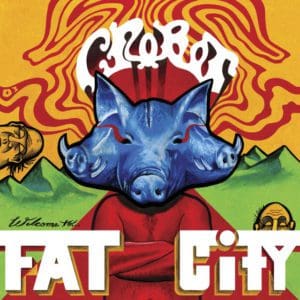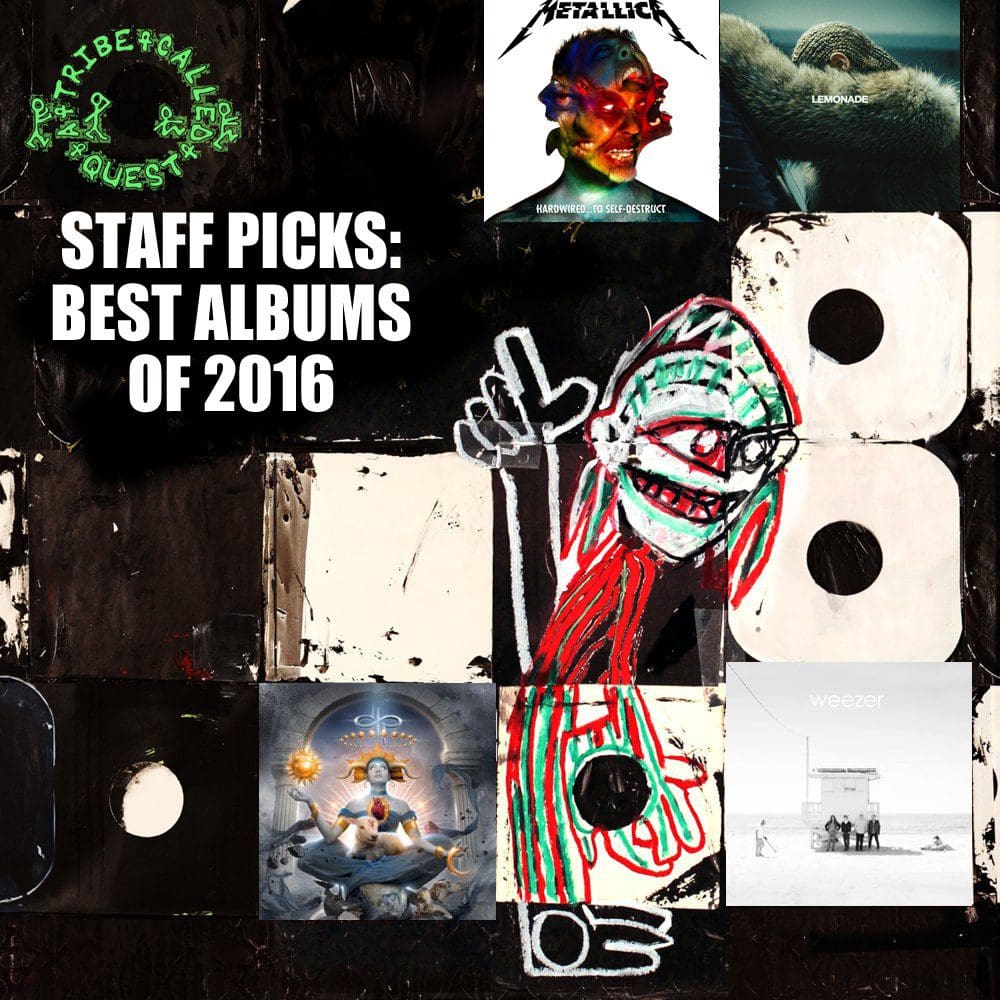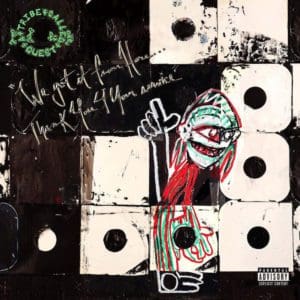The Pop Break staff has a uniquely diverse music taste, from heavy metal to hip hop to pop The Pop Break staff loves it all. This is easy to see in our choices for the Best Albums of 2016.
7. Transcendence – Devin Townsend Project (Nick Porcaro)
Somehow, some way, Devin Townsend’s seventeenth solo album is his most diverse and polished effort to date. Transcendence covers the full sonic capabilities of Canada’s favorite prog-metal prodigy, veering from poppy to operatic to extreme with acoustic and ambient passages sprinkled throughout. In anticipation of the album release Townsend spoke of a greater collaborative process with his bandmates, and nowhere is this more evident than in the drumming of Ryan van Poederooyen. RVP turns in a career-defining performance; his dazzling and intricately syncopated grooves lead the songs instead of serving as mere accompaniment. van Poederooyen’s increased confidence allows Devin to hone in on his powerful vocals and rich sense of melody, simplifying his guitar riffage to work around the chord changes. Look no further than “Stormbending”, an instant classic that alternates between passionate verses and tumultuous instrumental breaks. And if the strong melodies and rhythms weren’t enough, Townsend’s mammoth production job seals the deal. His guitar tones sound richer than ever, the drums more thunderous, and the vocals lushly layered as always. “Take me higher!”, Devin screams on the near ten-minute epic “Higher”—here’s hoping he continues to let us come along for the ride.
6. Magma – Gojira (Lucas P. Jones)
Gojira’s new album, Magma, was one of the most highly anticipated albums of 2016. Known for their crushingly heavy riffs and frenetic energy, the denizens of the metal world waiting with bated breath for the album’s release. What we got is…something different. But maybe, something better. Magma takes a sharp left turn from Gojira’s other albums right from the beginning. Trading traditional tech-death motifs in for a heavy, sludgy, atmospheric variant of the metal genre. “Silvera” has the three best riffs of 2016, all in one song. “Shooting Star” is haunting in its ambiance. The album is a wonderful display of musicality and virtuosity
By combining clean, airy vocals with truly impressive songwriting, instrumentation, and sprinkling in classic, heavy, complex riffs, Gojira has elevated what we expect from the heavy metal genre. This is an example of what happens when a band decides to try something different, commits, and executes. Magma is simultaneously melodic, heavy, frantic, groovy, and technically impressive. The fact that this album is getting the band mainstream exposure, as well as making even the most trve kvlt head-bangers, well, head-bang, is all the proof you need to see why this album deserves to be on every music lovers playlist. In a year full of outstanding metal, Magma stands above the rest. Now if you’ll excuse me, I’m late for my neck re-adjustment.
5. Weezer (The White Album) – Weezer (Al Mannarino)
I remember reading a Cracked article a few years ago, “4 Artists Who Should Probably Just Take a Break for a While.” The writer names a few that really made sense, especially Johnny Depp and Tim Burton, but the one that shocked me was Weezer. Weezer have been a staple of the alternative rock genre since they first burst on the scene with Buddy Holly and their self-titled Blue Album in 1994. They were the perfect response to the grunge scene that had swept the country with bands like Nirvana and Pearl Jam. They were fun, catchy, and above all else, different. The problem the writer has was they never really changed after their first two critically-acclaimed albums, the aforementioned Blue Album and Pinkerton.

It was ironic that Weezer ended up taking a break and focusing on what would be their comeback album in 2014, Everything Will Be All Right In The End, sounded like the Weezer of old and reinforced the notion that Weezer not only belonged in music, but they are needed. They are always putting out music for their diehard fanbase and constantly touring all over the world.
While no one can argue that 2016 was a horrible year for pop culture (and the rest of the world), it was an amazing year for music. Weezer followed up their comeback album with another self-titled color album that was equal parts “old Weezer” and “new Weezer.”
It feels more like a concept album than anything else. I wonder if Rivers Cuomo and company went into the recording studio and decided to make their own version of a Beach Boys record. Summer in California is the overall theme of the album, but the way the album flows feels like it could be the quintessential summer soundtrack. The beginning of the album is the start of summer when you can’t wait to enjoy the time off, with songs like “California Kids”, an upbeat and bright song about the start of summer and hanging out with your friends, and “Wind In Our Sails”, which talks about being carefree and not worrying about anything that comes your way.
The middle of the album focuses on the people you meet and the fun that’s to be had in the summer, including tracks “Thank God For Girls” and “Girl We Got A Good Thing”, which are all about meeting the perfect girl and summer love.
By the end of the album you have had your adventure, the girls you met were only around for the summer, and now it’s time to go back to reality, as explained in “L.A. Girlz” and “Jacked Up”, which mention the trouble you have with summer flings and how attached you can get to people you meet. The final song is “Endless Bummer”, where Rivers sings:
I just want this summer to end
What’s the point of trying to pretend?
There’s not a weak spot on the album, and it’s hard to listen to one track without wanting to hear the whole thing from start to finish. That’s how you can truly measure if an album deserves to be on an end-of-year list. This album didn’t need a big single or comeback hype surrounding it. It’s Weezer at their best and an album I will look forward to hearing every year once it starts to get warm out.
4. Welcome to Fat City – Crobot (Anthony Toto)
“Who paid your debt to be here/ No one/ My soul is not for sale,” screams Crobot’s Brandon Yeagley as his ferocious delivery captures the spirit of a band staying true to their musical roots while the world comes along for the ride.
This past fall, Crobot released their highly anticipated sophomore album Welcome To Fat City on Wind-Up Records. Here at The Pop Break, we have documented the band’s entire career thus far and witnessed their transition from playing small clubs to opening for legendary acts such as Motörhead, Volbeat, and Anthrax. The Pennsylvania act’s debut LP Something Supernatural is one of the definitive rock records of this decade and even the almighty Lemmy Kilmister expressed his fondness for their material.
As it pertains to sophomore releases, some groups collapse from the pressure of writing a successful follow-up and the great ones maximize the opportunity to reach new heights by enhancing their own sound. Crobot most certainly falls into the latter category – new heavy hitters such as “Not For Sale”, “Plague of the Mammoths”, and “Moment of Truth” resurrect a rock n’ roll blueprint that was established in the 70s, revived in the early ’90s, and recently enhanced to cure the world’s drought of authentic hard rock.

Welcome To Fat City initially recalls the grooviest moments of Something Supernatural yet stylistically moves in a different direction with each track as Crobot incorporates darker and heavier nuances into their musical DNA. Without comparing them to other acts, the changes across Welcome To Fat City recall the likes of sophomore classics such as Pearl Jam’s Vs., Stone Temple Pilots Purple, and Queens of the Stone Age Rated R. Historically speaking, all three acts managed to surpass or match the brilliance of their highly acclaimed debuts yet explored unconventional territory and maintained their substantial hooks – Crobot joins an exclusive group of artists in this respect.
Case in point, “Not For Sale” feels like a hard hitting declaration about this band’s musical authenticity; like no matter how fast the world is moving around them – Crobot is 100% focused on their music. I interviewed the band in September and in the words of Brandon Yeagley, “Focus on doing what you do best and don’t let anybody else tell you that they paved the way for you.” The rhythm section comprised of brothers Jake and Paul Figueroa commandeer the spotlight with a hook-laden gallop reminiscent of vintage Iron Maiden. The bluesy nuances in guitarist Chris Bishop’s note selection effortlessly shifts into desert metal territory reminiscent of Kyuss around the 2:03 mark yet proceeds to funk along the lines of vintage Led Zeppelin.
Once again, the band collaborated with renowned producer Machine and recorded their latest album in Austin, Texas. To Machine’s credit, he pushed the Pennsylvania act to embrace the metal elements of their sound without sacrificing their quench for infectious grooves. Over the last few years, Crobot shared the stage with Killswitch Engage and Sevendust, and perhaps the aggressive dynamics of those bands were subconsciously soaked into the band’s mindset for this record.
“Plague of the Mammoths” certainly lives up to the term “mammoth” since it is the hardest hitting track in Crobot’s catalog. If any rock radio programmer doesn’t have this song added to their daily playlist, well, shame on them since “Plague of the Mammoths” is the definitive hard rock anthem of 2016. Welcome To Fat City came out in September 2016 and something about this song in particular captures the climate of the final quarter of 2016 – a year comprised of death and disheartening events. From a listeners standpoint, one could hear each instrument fluidly come together to form this monstrous groove before Yeagely’s high register adds another notch of unrelenting power. The chorus immediately stands out for its eloquent doses of anger and melody. The transitional riff at the 1:45 mark features virtuosic levels of synchronized guitar, bass, and drums, which recalls the likes of Soundgarden’s Superunknown and Black Sabbath’s Master of Reality.
“Hold On For Dear Life” also utilizes the aggressive tonalities of doom metal yet summons the bluesy aura of legendary guitarists such as Stevie Ray Vaughan. As I stated earlier, this album was recorded in Austin, Texas and each song possesses the emotional innocence of southern blues and Texas swing. “Hold On For Dear Life” also features one of Brandon Yeagley’s greatest vocal performances to-date – every note of his bark could felt from the opening line forward. In 2016, rock listeners heavily diverted their attention on nostalgic acts such as Guns N’ Roses yet we have a frontman who consistently unleashes every ounce of his energy on stage as well as in the studio. This vocal performance is one of many acrobatic demonstrations of Yeagley’s range that solidifies his status as one of the best frontmen in modern rock.
“Right Between The Eyes” is one of Welcome To Fat City’s standout anthems where the metal riffage spikes the adrenaline to peak levels of intensity. Yeagley sings the line, “Hit you right between the eyes,” which allows the guitar, bass, and drums to lose control and bash the listener like Rage Against The Machine. Nobody else in modern rock could duplicate their effortless combinations of blues, funk, and metal. Some listeners might compare the group’s previous work to other established rock acts yet Crobot’s charisma is unmatched. These four musicians share a genuine vision and recognize how each member respectively adds an irreplaceable element to the fold.
For fans who enjoyed the funkier elements of their debut, songs like “Play It Cool” possess the irresistible displays of wah-laden guitar leads, cowbell, and rhythms that rumble along the lines of Grand Funk Railroad. From a production standpoint, this album sounds even looser than Something Supernatural and that record felt like the band performed right in front of our eyes. This time around; the guitar tones sound more distorted and looser compared to Something Supernatural, which played a huge role in the evolution of Crobot’s sound from the opening riff of “Welcome To Fat City.” On songs like “Easy Money”, Bishop distinguishes himself from the classic rock revivalists with such a unique melody that sounds vintage yet could certainly attract modern metal listeners with its aggressive delivery. His orange amplifiers summon a healthy mix between Hendrix-infused blues and Badmotorfinger era Soundgarden.
Without question, Welcome To Fat City is my choice for the best rock record of 2016. Something Supernatural is one of my favorite records in recent memory yet this album managed to pull off the impossible and surpass its predecessor. Truth be told, I did not want to hear Crobot duplicate their previous effort and their darker approach was the right path to pursue. I applaud them since they maintained the funk mythos of their sound and explored so many new directions all across this record. Crobot are one of the very few modern acts who could thrive in any style or setting since their influences are so diverse – there are hints of artists ranging from Primus to Corrosion of Conformity. To Machine’s credit, he understands the full spectrum of Crobot’s tastes and utilizes old school techniques to preserve the magnitude of their live identity. The beauty of Crobot’s magic – whether they perform in front of 20 or 2,000 concert attendees – they jam away as if the apocalypse were bound to occur tomorrow and their success has been earned due to their work ethic. If you never listened to Crobot beforehand, drop whatever is that you are doing and find this record. In the year 2016, “The Moment of Truth” is Crobot solidified their status as the best hard rock band of the world.
3. Lemonade – Beyonce (Marisa Carpico)
It started with “Formation.” Released just a day before Beyoncé stole the Super Bowl halftime show with her very first live performance of it, the song was a lightning rod. She was unequivocal in her support of the Black Lives Matter movement and some cultural commentators seemed downright perturbed that a pop star who had previously been almost apolitical would make such a clear, opinionated statement. Regardless, “Formation” is a great song. But here’s the thing about it: Lemonade is such a masterpiece of an album that the song was relegated to the credits sequence when the movie version first aired on HBO.
If “Formation” was a lightning rod, then Lemonade the film/album was the storm itself. It’s hard to argue that any other piece of pop culture had a larger impact this year. When Self-Titled dropped in late 2013, it was a statement, not just of the pop artist Beyoncé had become, but of what it meant to be a woman in that moment in history. Lemonade is an equally comprehensive statement—if much more blistering.
Watching the film version of the album, it quickly becomes clear that something dark happened in the Knowles-Carter household. Though Bey and Jay-Z have never really addressed the rumors of his infidelity, it seems hard to deny given the imagery, lyrics and poetry (by Warsan Shire) throughout Lemonade. Hell hath no fury like a woman scorned and Beyoncé’s rage and betrayal is palpable in the early songs. The first time I watched the film, I wondered if it was an elaborate way for Bey and Jay to announce their divorce. However, Lemonade is not so much about revenge as it is about working through the stages of betrayal, about one woman slowly moving from anger to acceptance in front of the whole world.
However, as revealing and personal as Lemonade is, it is also–undeniably–universal. The triumphant, screw you anger of “Hold Up” and “Sorry” are recognizable and cathartic to any woman who has ever been cheated on. “Daddy Lessons” (arguably the year’s best country track) is a treatise on the profound effects of disappointing father figures—both literal and figurative. “Freedom” extends that disappointment to that most powerful of patriarchal figures, America itself. And then “All Night Long” breaks through all that anger and disappointment to bring us forgiveness and hope, reminding us that even when the things we love betray us, they deserve the chance to improve and correct those mistakes. What message could be more vital and meaningful after 2016 than that?
2. Hardwired…to Self-Destruct – Metallica (Bill Bodkin)
This was definitely worth the eight year wait.
Hardwired…to Self-Destruct may not be the best Metallica album of all-time. Hell, it’s not the best record the band has released in this 17 year old century. However, it’s still a really, really good album rife with ready made classics.
The first three singles “Hardwired”, “Moth into Flame”, and “Atlas, Rise!” were dropped in successive order, and it was a great strategy. These are the three strongest cuts off the album, and it helped build crazy, crazy hype for this record.
Some have criticized this album for being “too Metallica” — but I beg to differ. While it wasn’t as “avant garde” as Saint Anger, it definitely took more chances. Sonically and vocally there were more risks taken by this band than they have in years. At this point in their career Metallica doesn’t need to risk anything, so that’s why it’s so cool to hear them do it.
If you’re looking to thrash to some tracks off the record, you can’t go wrong with the first three singles that we mentioned. However, there’s also “Dream No More”, a cousin to the classic “Sad But True”, the epic, blistering banger “Spit Out the Bone”, and the riff-tastic “Now That We’re Dead”.
Where does this album rank? It’s a few steps behind Death Magnetic, but it is definitely in the conversation for a “classic” ‘Tallica record.
1. We Got It from Here… Thank You 4 Your Service – A Tribe Called Quest (Angelo Gingerelli)
In an era where most Hip-Hop artists release new projects every 18 months, A Tribe Called Quest somehow released the best album of the year a full 18 years after their last LP. While nearly two decades is a long time between projects in any genre it’s an eternity in Hip-Hop and yet ATCQ released an album that was relevant and relatable to both longtime fans that bought their classic albums on cassette tape and their kids that weren’t even born when a young Busta Rhymes spit his breakout verse on “Scenario.”
We Got It from Here… Thank You 4 Your Service is also the rare case of a great album being released at exactly the right time. Even though it wasn’t released until November, it immediately moved to the forefront of rap albums released in a year where the biggest artists (Jay-Z, Eminem, Lil’ Wayne, Nicki Minaj) didn’t release projects, some of the biggest MC’s released disappointing LP’s (Drake, Kanye, Future) and a new crop of “mumble rappers” (Lil Yachty, Lil Uzi Vert, DRAM) had hot singles, but seemed completely uninterested in releasing traditional albums. Also, releasing mere days after the election of Donald Trump songs like Space Program, We the People and The Donald addressed the uneasiness many citizens felt about America’s political climate.
While We Got It from Here… works on multiple levels, it’s ultimately an example of a legendary group using all of the tools in their toolbox to create one last great work of art. The song concepts are all tight and timely, the beats are somehow both classic-Tribe and undeniably 2016, the verses from group members all work, guest appearances that range from Kendrick Lamar to Elton John all contribute to the bigger picture and the finished product proved that this creative collective is still capable of making great, timeless Hip-Hop.
It’s bittersweet that 2016 saw both the triumphant return of A Tribe Called Quest and the untimely passing of Phife Dawg. Rest in Peace to the “5 Foot Assassin” and thanks for all the Beats, Rhymes & Life.







